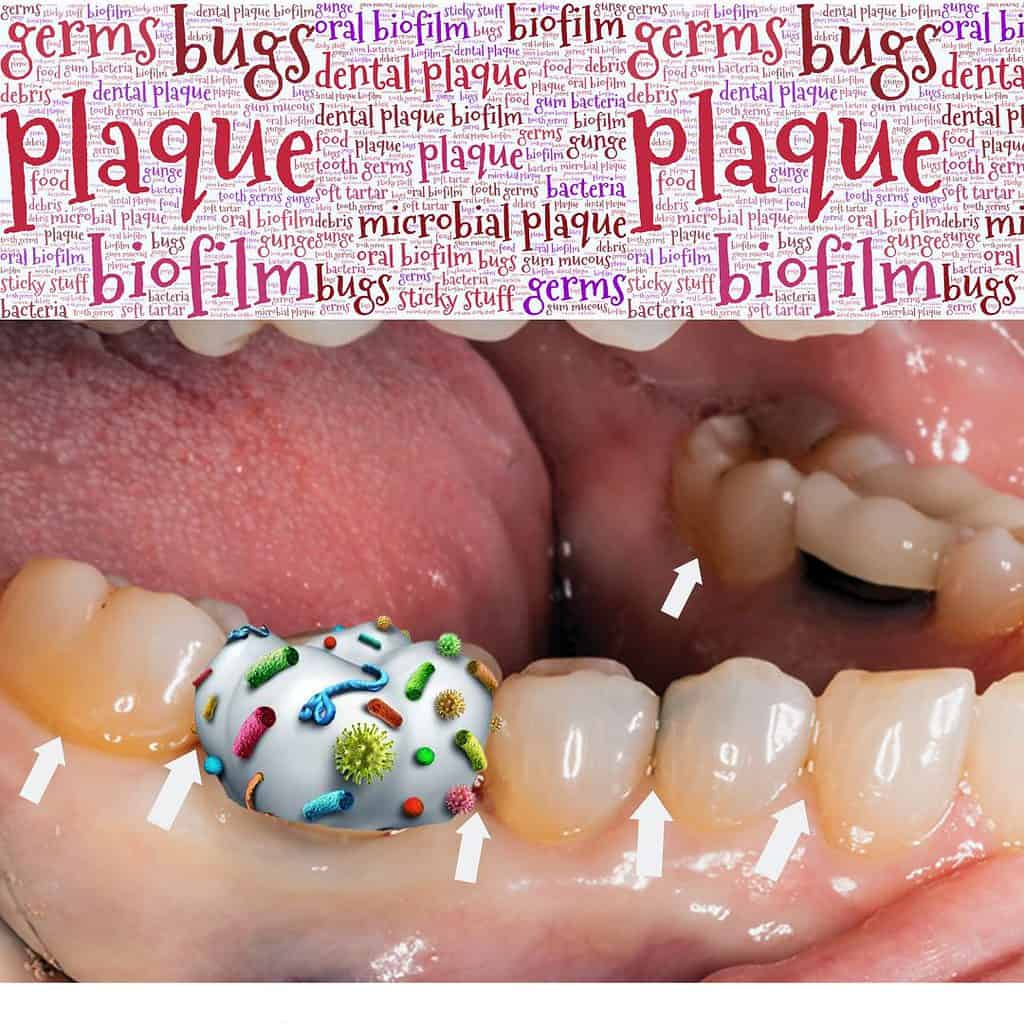
Brush twice a day with a manual or electric toothbrush and fluoride toothpaste

Aim to brush thoroughly to disrupt the bacterial plaque biofilm from every surface of all teeth and gum line without damaging tooth surfaces, gum or other soft tissues in the mouth. Plaque biofilm will gather on all surfaces including fillings, dental implants, appliances etc. Brushing thoroughly will remove approx 60-70 of the plaque biofilm from your teeth. To do well, toothbrushing takes time and attention. Watch what you are doing and where you are placing the toothbrush bristles. The surfaces your toothbrush can’t reach should be cleaned using suitable interdental cleaning aids.
It is important to brush before bed and one other time every day. Clean between teeth BEFORE brushing or at a different time. This allows fluoride and any other active ingredients in toothpaste to reach the surfaces between teeth where your toothbrush can’t reach. By keeping your teeth clean you will help reduce the risk of tooth decay, gum disease, mouth infections and bad breath. Periodontal (gum) disease is linked with 57 non communicable diseases, so cleaning your teeth well benefit not only your mouth and oral health, but also your overall health and wellbeing.
Start toothbrushing as soon as the first tooth appears. Young children will need an adult to brush their teeth for them and it is recommended that children are supervised when tooth brushing until at least the age of 7.

A general guide is when children can tie their shoe laces without help they can brush. Children and young people between 6 and 16 undergo a lot of changes in their mouths and should be supervised and supported to ensure tooth brushing is effective.

The app BrushDJ can be a great help in encouraging toothbrushing. BrushDJ is a free toothbrush timer app that plays 2 minutes of music taken from the user’s device (phone, tablet etc) to encourage brushing for an effective length of time.
Download our toothbrushing chart to encourage regular toothbrushing.
Children may not be the only ones who may need help with brushing – lots of factors can make it difficult to clean teeth thoroughly and maintain good oral health. These factors can include having an injury e.g. a sprained wrist or an illness such as dementia. Check out our oral hygiene video playlist.
Top tips for toothbrushing:
1. Choose a fluoride toothpaste
All children up to the age of three should use a smear of toothpaste with at least 1000ppm fluoride, before bed and at one other time every day (most people choose when they get up in the morning). Use a smear of toothpaste. DO NOT let children lick or eat toothpaste from the tube. Find tips for toddler toothbrushing here.

Between the ages of 3-6 years, it is recommended to use a pea sized blob of toothpaste containing at least1000ppm fluoride.
From age 7, use toothpaste containing between 1350ppm and 1500ppm fluoride. Use a pea sized blob of toothpaste.
Fluoride strength is listed in the ingredients on the back of the toothpaste tube as ppm (parts per million). Click here for our TOOTHPASTE GUIDE.
2. Use a dry toothbrush
Use a soft-medium toothbrush. There is no need to wet the toothbrush first – the mouth is already warm and moist. A hard toothbrush (especially if with an abrasive toothpaste or toothpaste tablets) can wear tooth surfaces away and damage gums.
Spread the toothpaste around all tooth surfaces first (to ensure even coverage), then watch in a mirror while you brush to make sure that each surface of every tooth is cleaned thoroughly. Aim to place the bristles where the gum and tooth meet then brush in small circular motions (if using a manual toothbrush), or just hold the bristles in place at the gum line if using with an electric brush. Use GENTLE pressure – you aren’t scrubbing the floor! Think dusting rather than scrubbing!
3. Electric v manual toothbrush
It is more important to focus on the quality of brushing rather than the brush you use. The aim is to clean both teeth and gums, without doing any harm to either.
The technique for brushing with an electric toothbrush is different to using a manual toothbrush. With an electric toothbrush the power makes the bristles move – there is no need to move the brush back and forth or in a circular motion – simply hold it in place on the surface of the tooth at the gum line and let the power do the work.

Whatever you use, take the time to brush each surface of every tooth – outside, inside and biting surface. Click here to watch our demo video. Spend at least two minutes brushing at night time and one other time of the day. This equates to brushing each surface for approximately 1.5 seconds (the time it takes to count of five).
4. Spit out after brushing but don’t rinse
Do not rinse your mouth out with water after brushing. This leaves toothpaste on the teeth to get the maximum benefit from toothpaste ingredients e.g fluoride, desensitising etc.
AFTER brushing, rinse the toothbrush bristles under running water, nip the bristles together to help keep their shape, then store out of contact with other people’s toothbrushes.
Replace toothbrushes or electric toothbrush heads when the bristles start to splay out (approximately every 3 months).
5. Check how well you brush.

Use disclosing toothpaste or tablet to stain the plaque biofilm so you can easily see where you are missing.
Really up your game by adding a single tufted brush for solo toothbrushing. Find out how here.


Check out our 2 minute toothbrushing video to help you spend time brushing thoroughly – good for oral and overall health and wellbeing.
You may have heard of, or been advised by your dental team to use the Bass or Modified Bass toothbrushing technique. Quintessence Publishing has produced this short video describing the bass technique.


